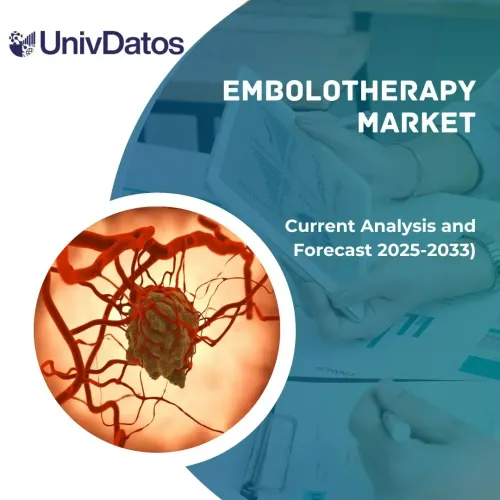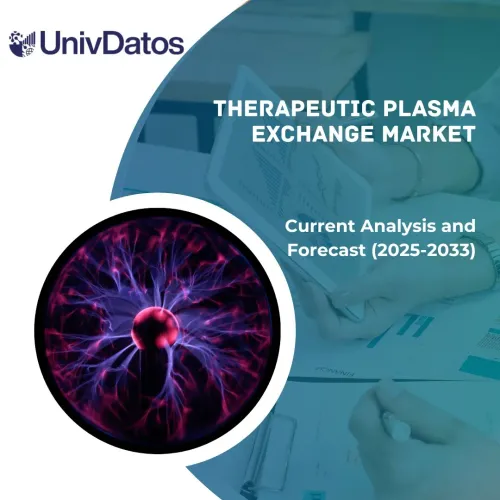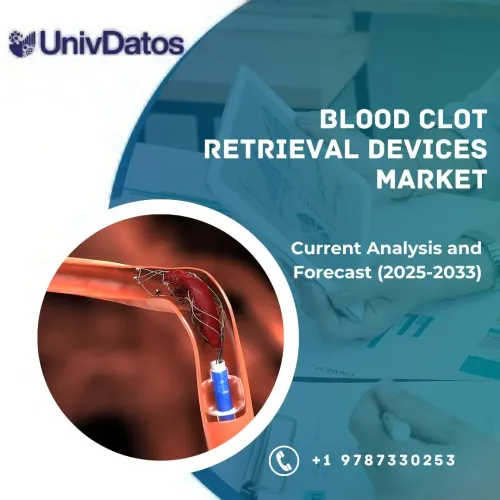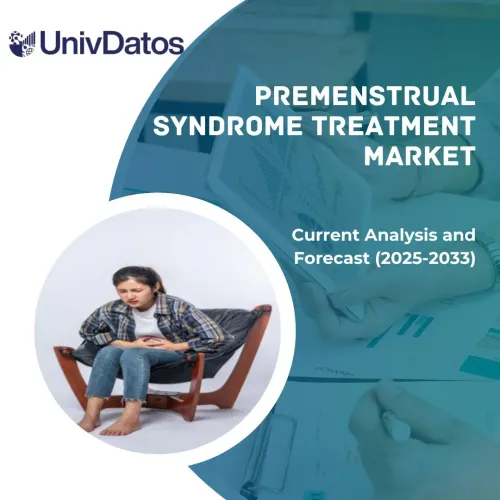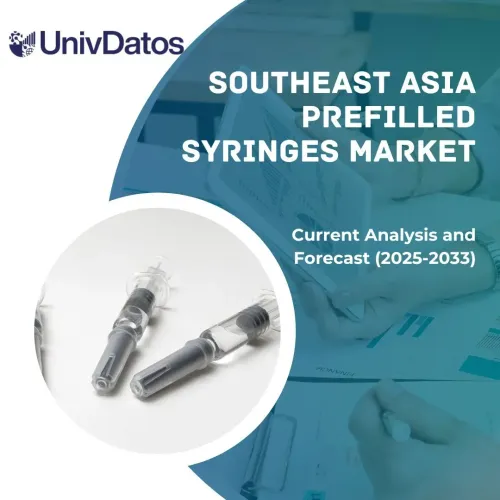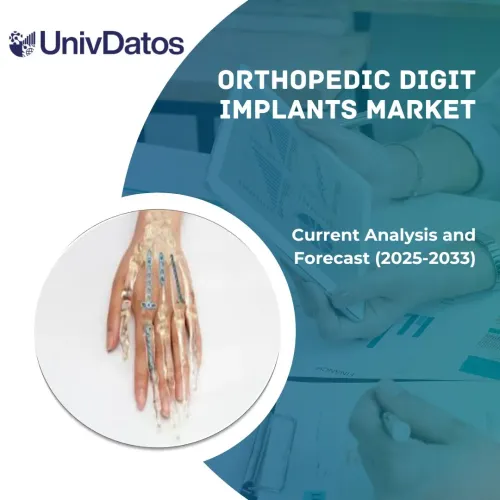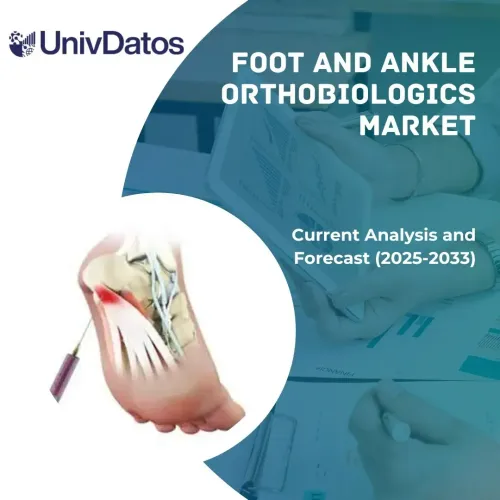- Home
- About Us
- Industry
- Services
- Reading
- Contact Us
Allergy Treatment Market: Current Analysis and Forecast (2021-2027)
Emphasis on Type (Eye Allergy, Skin Allergy, Food Allergy, Asthma, Rhinitis, and Others); Distribution Channels (Hospital Pharmacies, Retail Pharmacies, Online Retailers, and Others); Treatment Type (Anti-Allergy Drugs and Immunotherapy); Dosage Form (Oral, Inhalers, Intranasal, and Others); Region and Country
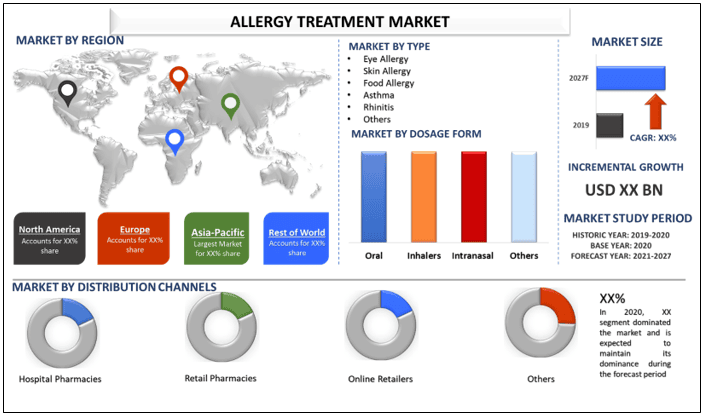
Allergy Treatment Market was valued at US$ 25 billion in 2020 and is expected to registering a CAGR of 7% during the forecast period (2021-2027). An allergic reaction is the natural response of the body towards the harmful substance known as allergens. These allergens are generally present in the environment such as grass pollen, dust mite, mold, egg, soy, wheat, milk, etc. Exposure to these allergens can lead to several allergic disease conditions such as Eye Allergy, Skin Allergy, Food Allergy, Asthma, Rhinitis, and Others. The main symptoms of allergic reactions include sneezing, teary eyes, congestion, itching in the nose, throat, roof of mouth, eyes, and others. Also, the allergies due to several foods such as milk, soy, eggs, wheat, peanuts, tree nuts, fish, and shellfish can lead to symptoms like diarrhea, vomiting, and respiratory symptoms. The most common triggers for anaphylaxis, a life-threatening reaction, are food, medicines, and insect stings. Also, medicines lead to the most allergy-related deaths all over the world. According to the SingleCare survey in 2021, 7% of participants report an allergy to aspirin, ibuprofen, and other NSAIDs.
Key Facts on Allergy
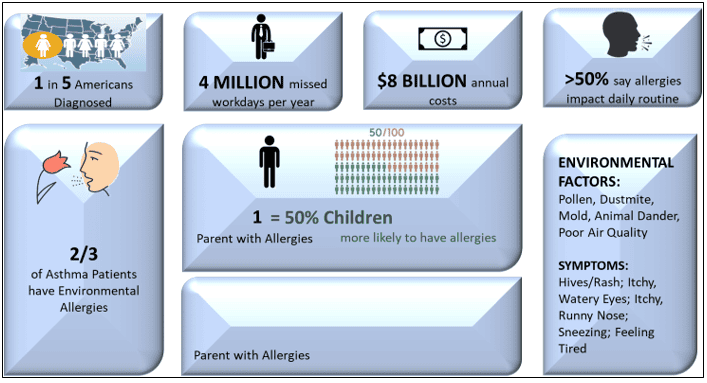
Insights Presented in the Report
“Amongst Type, Rhinitis segment hold the major share.”
Based on Type, the market is fragmented into Eye Allergy, Skin Allergy, Food Allergy, Asthma, Rhinitis, and Others. The Rhinitis segment dominated the market in 2020 and is expected to grow at lucrative growth owing to the rising prevalence of allergic rhinitis all over the world. Globally, 339 million are suffering from asthma, 200 to 250 million have a food allergy and 400 million have rhinitis. This drastic increase in the prevalence of allergic respiratory diseases like rhinosinusitis and bronchial asthma is due to environmental changes, industrialization, and immunologic interactions. Allergic rhinitis (hay fever) affects between 10 and 30 percent of all adults in the U.S. and as many as 40 percent of children. There are over 60 million people in the U.S. that are suffering from allergic rhinitis, and the number is continuously increasing.
“Amongst Distribution Channels, Hospital Pharmacies segment holds the major share.”
Based on Distribution Channels, the market is fragmented into Hospital Pharmacies, Retail Pharmacies, Online Retailers, and Others. The Hospital Pharmacies segment dominated the market in 2020 owing to the surging number of hospitals and infectious diseases worldwide.
“Amongst Treatment Type, Anti-Allergy Drugs segment holds the major share.”
Based on Treatment Type, the market is fragmented into Anti-Allergy Drugs and Immunotherapy. The Anti-Allergy Drugs segment dominated the market in 2020 and is expected to grow at lucrative growth during the forecasted period owing to the convenience of self-administration, compactness, and easy manufacturing of oral dosage forms. Anti-Allergy Drugs include an antihistamine (brompheniramine and cetirizine), corticosteroids (dexamethasone), mast cell stabilizers (cromolyn), decongestants (phenylephrine), and other medicine (Anti-IgE, Leukotriene). The introduction of newer forms of immunotherapy i.e., ‘sublingual immunotherapy’ also intensifies the segment growth. For instance, in April 2017, the U.S FDA approved a house dust mite sublingual immunotherapy tablet for the treatment of house dust mite-induced allergic rhinitis in adults. Moreover, the rise in the patient pool suffering from different types of allergies is a major factor driving the market.
“Amongst Dosage Form, Oral segment holds the major share.”
Based on Dosage Form, the market is fragmented into Oral, Inhalers, Intranasal, and Others. The Oral segment dominated the market in 2020 and is expected to grow at lucrative growth during the forecasted period. Anti-allergy oral drugs have the advantage of self-usage and easier manufacturing processes which aids in the segment growth. The use of antihistamines for chronic allergies and corticosteroids like prednisolone which can be taken orally intensifies the segment growth. Increasing R&D in allergies and their treatment is expected to boost the growth of the market. For instance, in November 2019, research conducted by the Center for Allergy and Asthma Research at Stanford University and funded by AnaptysBio, Inc. found that a single dose of etokimab could have the potential to desensitize peanut-allergic participants and possibly reduce atopy-related adverse events.
“North America region signifies one of the largest markets and is expected to be the fastest-growing markets of Allergy Treatment market.”
For a better understanding of the market adoption of Allergy Treatment, the market is analyzed based on its worldwide presence in the countries such as North America (United States, Canada, and the Rest of North America), Europe (Germany, France, Spain, United Kingdom and Rest of Europe), Asia-Pacific (China, Japan, India, Australia, and Rest of APAC), and Rest of World. North America is expected to dominate the Allergy Treatment market on account of increasing per capita healthcare expenditure and the presence of technologically advanced healthcare infrastructure in the region. As per OCED, the healthcare spending by the government as a percentage of GDP in the countries such as U.S , Canada, France, Germany, Mexico, U.K and turkey has been increased from 16.71% to 16.96%, 10.68% to 10.79%, 11.46% to 11.18%, 11.16% to 11.65%, 5.75% to 5.47%, 9.90% to 10.25%, 4.13% to 4.37% during 2015-2019 respectively. Some of the major players operating in the market include BioMérieux, Danaher Corporation, GlaxoSmithKline plc, Hitachi Chemical Diagnostics, Inc., Merck & Co., Inc., Omega Diagnostics Group PLC, Siemens Healthcare, Thermo Fisher Scientific, Inc., Genetech Inc., and Allergan Plc. Several M&As along with partnerships have been undertaken by these players to boost their presence in different regions.
Reasons to buy this report:
- The study includes market sizing and forecasting analysis validated by authenticated key industry experts
- The report presents a quick review of overall industry performance at one glance
- The report covers an in-depth analysis of prominent industry peers with a primary focus on key business financials, product portfolio, expansion strategies, and recent developments
- Detailed examination of drivers, restraints, key trends, and opportunities prevailing in the industry
- The study comprehensively covers the market across different segments
- Deep dive regional level analysis of the industry
Customization Options:
The Allergy Treatment market can further be customized as per the requirement or any other market segment. Besides this, UMI understands that you may have your own business needs, hence feel free to connect with us to get a report that completely suits your requirements.
Table of Content
Analyzing the historical market, estimation of the current market, and forecasting the future market of the Global Allergy Treatment market were the three major steps undertaken to create and analyze the adoption of Allergy Treatment for the different allergy type such as Eye Allergy, Skin Allergy, Food Allergy, Asthma, Rhinitis, and Others. Exhaustive secondary research was conducted to collect the historical market numbers and estimate the current market size. Secondly, to validate these insights, numerous findings and assumptions were taken into consideration. Moreover, exhaustive primary interviews were also conducted, with industry experts across the value chain of the Allergy Treatment sector. Post assumption and validation of market numbers through primary interviews, we employed a top-down/bottom-up approach to forecasting the complete market size. Thereafter, market breakdown and data triangulation methods were adopted to estimate and analyze the market size of segments and sub-segments the industry pertains to. Detailed methodology is explained below:
Analysis of Historical Market Size
Step 1: In-Depth Study of Secondary Sources:
The detailed secondary study was conducted to obtain the historical market size of the Allergy Treatment through company internal sources such as annual reports & financial statements, performance presentations, press releases, etc., and external sources including journals, news & articles, government publications, competitor publications, sector reports, third-party database, and other credible publications.
Step 2: Market Segmentation:
After obtaining the historical market size of the Allergy Treatment market, we conducted a detailed secondary analysis to gather historical market insights and share for different segments for major regions. Major segments included in the report are type, distribution channels, treatment type, dosage form, and Region/Country. Further country-level analyses were conducted to evaluate the overall adoption of Allergy Treatment in every region.
Step 3: Factor Analysis:
After acquiring the historical market size of different segments and sub-segments, we conducted a detailed factor analysis to estimate the current market size of Allergy Treatment. Further, we conducted factor analysis using dependent and independent variables such as the rising number of Allergies all over the world.
Current Market Size Estimate & Forecast
Current Market Sizing: Based on actionable insights from the above 3 steps, we arrived at the current market size, key players in the Allergy Treatment Market, and market shares of the segments. All the required percentage shares split, and market breakdowns were determined using the above-mentioned secondary approach and were verified through primary interviews.
Estimation & Forecasting: For market estimation and forecast, weights were assigned to different factors including drivers & trends, restraints, and opportunities available for the stakeholders. After analyzing these factors, relevant forecasting techniques i.e., the top-down approach was applied to arrive at the market forecast about 2027 for different segments and subsegments across the major markets globally. The research methodology adopted to estimate the market size encompasses:
- The industry’s market size, in terms of value (USD) and the adoption rate of Allergy Treatment across the major markets domestically
- All percentage shares, splits, and breakdowns of market segments and sub-segments
- Key players in the Allergy Treatment market in terms of services offered. Also, the growth strategies adopted by these players to compete in the fast-growing market.
Market Size and Share Validation
Primary Research: In-depth interviews were conducted with the Key Opinion Leaders (KOLs) including Top Level Executives (CXO/VPs, Sales Head, Marketing Head, Operational Head, and Regional Head, Country Head, etc.) across major regions. Primary research findings were then summarized, and statistical analysis was performed to prove the stated hypothesis. Inputs from primary research were consolidated with secondary findings, hence turning information into actionable insights.
Split of Primary Participants in Different Regions
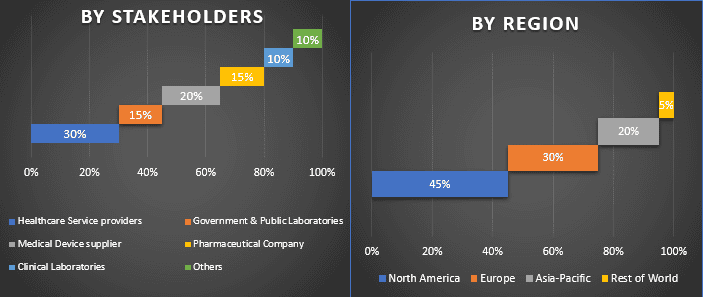
Market Engineering
Data triangulation technique was employed to complete the overall market estimation and to arrive at precise statistical numbers of each segment and sub-segment of the Allergy Treatment market. Data was split into several segments & sub-segments post studying various parameters and trends in the areas of Type, Distribution Channels, Treatment Type, and Dosage Form, and Region of the Allergy Treatment market.
Main Objective of the Allergy Treatment Market Study
The current & future market trends of the Allergy Treatment Market are pinpointed in the study. Investors can gain strategic insights to base their discretion for investments from the qualitative and quantitative analysis performed in the study. Current and future market trends would determine the overall attractiveness of the market at a regional level, providing a platform for the industrial participant to exploit the untapped market to benefit as a first-mover advantage. Other quantitative goals of the studies include:
- Analyze the current and forecast market size of Allergy Treatment Market in terms of value (USD). Also, analyze the current and forecast market size of different segments and sub-segments of the sector
- Segments in the study include type, distribution channels, treatment type, dosage form, and Region/Country
- Analyze the value chain involved with the presence of various intermediaries, along with analyzing customer and competitor behaviors pertaining to the industry
- Analyze the current and forecast market size of the Allergy Treatment category across the globe. Major regions analyzed in the report include North America (US, Canada, Rest of North America), Europe (Germany, UK, France, Rest of Europe), Asia-Pacific (China, India, Australia, Singapore, Rest of Asia-Pacific), & Rest of World
- Define and analyze the competitive landscape of the Allergy Treatment sector and the growth strategies adopted by the market players to sustain in the fast-growing market
- Deep dive regional level analysis of the industry
Related Reports
Customers who bought this item also bought



